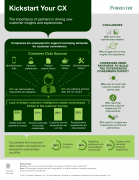Visa: Data Will Deliver Payments And Commerce 2.0

Anyone who’s ever checked into a hotel knows the drill.
Traveler, usually tired traveler, walks through the front door, approaches the front desk to check in, presents a method of payment and form of ID to authenticate herself, and is then presented with her room key.
But as Paul Walsh, Visa’s SVP of platform strategy and innovation, asked Karen Webster in a recent conversation: What would happen if that could be a much, much better experience?
“Instead, we imagine a world in which the guest is approaching the hotel in her car, taxi or Uber, and the hotel knows she is on her way and when she’s likely to arrive, thanks to geofencing,” Walsh said. “From there, the hotel can leverage all the data it already knows about her from her previous stays, and observes that she likes to be on the fourth floor, five doors down from the elevator. From there, the system can authenticate her, check her in and send her on her way to her room without ever having to make that time-consumer layover at the front check-in desk.”
Walsh posited that’s not a far-fetched dream, but a goal made possible by data – specifically, the application of the right kind of data – that removes friction from the process that consumers know, but probably don’t love all that much today.
Then, Walsh said, that same framework could be applied to retail.
What if retailers could know when a preferred customer is approaching the store, and recognize and personalize the experience the same way they do when that customer shops online? That, too, is about the application of the right kind of data that creates a much richer experience for the consumer – and a much more rewarding experience for the retailer.
There’s just one small problem, according to Visa’s newly released study in collaboration with Forrester: Deliver the Commerce Experiences of Tomorrow.
The vast majority of firms aren’t very well-equipped to do that.
Retailers have the data, because they’ve been dutifully gathering it for some time, according to the report – but they aren’t entirely sure how to assemble and make use of it.
“The problem is that the data is so fragmented within firms, and less than 50% of companies felt their current processes were effective.” Walsh noted in the report’s findings. “They are gathering it, but they are using incredibly homegrown offerings, like Excel sheets, to parse it.”
More discouraging is that this homegrown system doesn’t work very well today, and that prevents firms from making the next big leap into the future of commerce. Excel spreadsheets that capture stale data don’t do much to power the richer consumer experiences that require advanced analytics, artificial intelligence or predictive analytics – and data served in real or near real time.
Making matters worse, Walsh said, is that consumers want those experiences, and are fearless about adopting whatever innovations will get them there fastest. The data from the report shows that 71 percent of consumers will try a new technology if it will better satisfy their needs.
Retailers that “stand still” simply won’t survive.
So Why Is Progress So Slow? Let Me Count the (Four) Ways …
That was Karen Webster’s main question – because, she noted, it feels as though we’ve been talking about the great things that can happen when the power of data is applied to a variety of problems, including in retail, for a very long time.
If customers want it – which the data shows they do – and retailers know their survival depends on offering those experiences, why isn’t it happening more quickly?
As Walsh said, the data showed four pretty clear issues that retailers are facing:
- Cost of implementation and lack of budget
- The need to keep data secure
- A lack of understanding about what customers actually want
- A lack of actual internal skill to make any of these changes happen
That last concern, he noted, is the “feeder problem” that queues up the other three.
“If you think about what it means to live in a software-defined world, we are talking about new cars with 100 million lines of code, and smartphones that are averaging 1.2 million lines, so it is not an exaggeration to say the world is being rewritten in code,” Walsh noted. “The reality is that the vast majority of retailers are just not skilled enough in development and programming to go out and deliver that.”
In the past, Walsh pointed out, retailers were hesitant to give outsiders a chance to peek at their data; there was an overwhelming bias toward controlling it by limiting access.
However, as the omnichannel era is rolling on, and the demands are becoming increasingly technological in nature, firms are understanding that they need help.
“We see 75 percent of firms saying they need help in delivering the right capability, because we are moving past that ownership model,” said Walsh. “Seventy percent are saying the API economy is important; however, we heard that they don’t have the skills internally to do it.”
Brands aren’t willing to simply abandon their data and hope for the best. For example, the report demonstrates that brands are extremely concerned with ensuring that all data is secured and used appropriately, for fear of damaging their customers’ trust. But firms are also increasingly asking themselves how they can co-create with another brand to deliver the “right” experiences for their clients and customers.
The Age of the Consumer
Being the right third-party partner for a firm looking to expand into the next phase of payments and commerce, Walsh noted, involves engineering solutions that help everyone win.
“For example,” Walsh noted, “we’ve worked with PNC Bank over the Visa Developer platform to build in our API-based capabilities around the traveler.”
Those capabilities make it easy for a customer who is traveling out of the state or country to log in with their issuers, tell the bank where and when they plan to travel and then be on their way.
It’s a solution that obviously works for consumers, Walsh pointed out, because it allows everyone to avoid that dreaded moment when they are traveling abroad, offer to pay for dinner, forgot to tell their bank they were traveling and then have their card declined because their issuer thinks it has been stolen.
But, he noted, it is also a solution that also benefits the banks, making the guys counting the beans inside the organization pretty happy, too.
“[When they deployed this new program], PNC saw a 46 percent reduction in call center volumes in regard to travel,” Walsh said.
It is one example of what Walsh said VDP is doing to help co-create solutions that enable the incremental innovation that delivers big returns.
Because, Walsh said, what the data has shown, over and over, is that brands are now fully aware that they have to get this done – and they want a partner to work and collaborate with, and to accelerate their path to payments and commerce 2.0.
“This is the age of the consumer – they are really in the driver’s seat here, and their expectations are being raised all the time,” Walsh noted. “There is no more waiting: The time is now to think about data, and its use of it to meet, not exceed, those expectations.”

